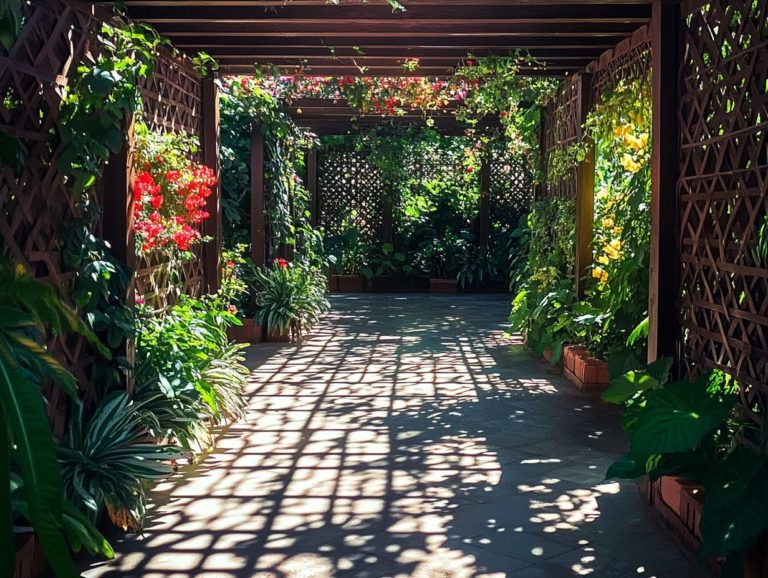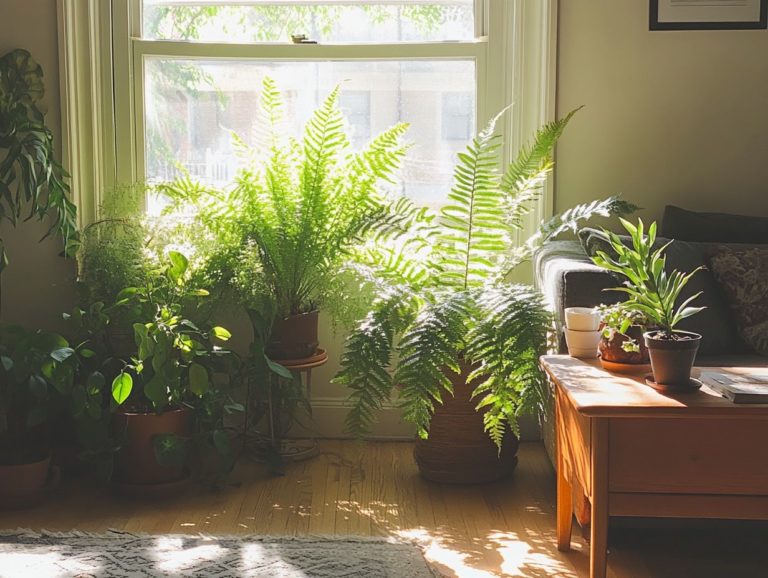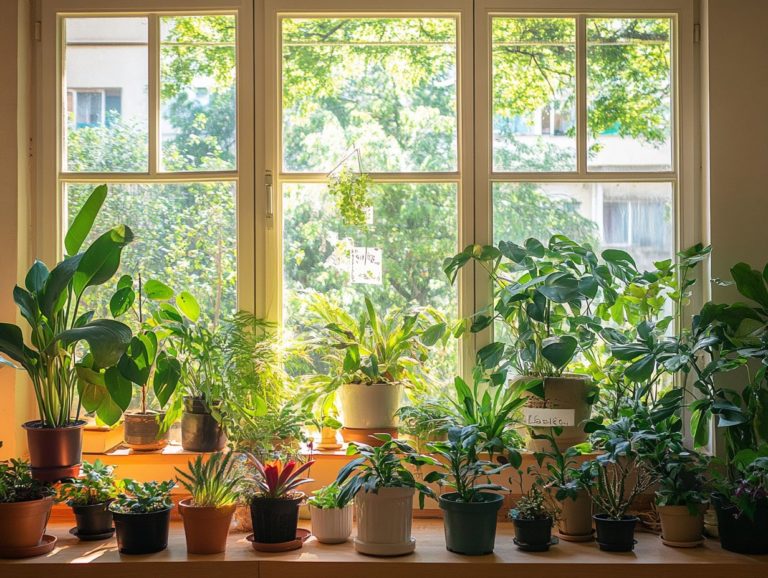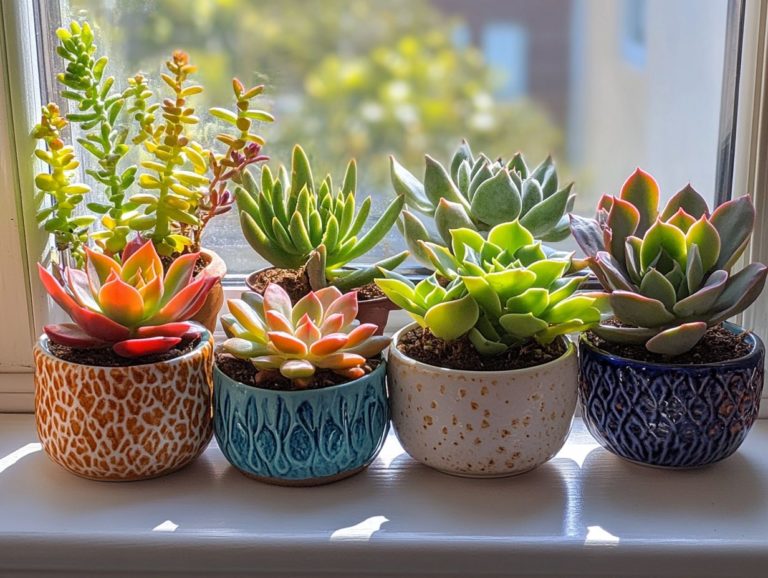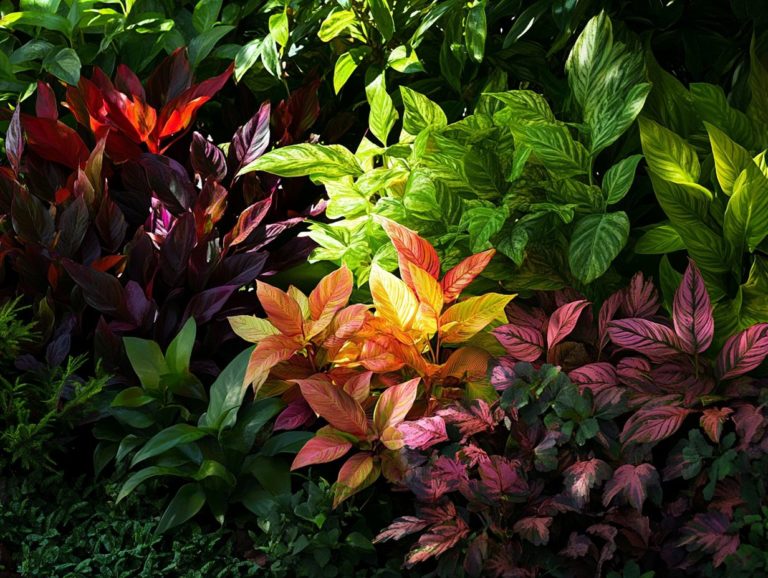Using Sunlight for Indoor Plants Effectively
Sunlight is the lifeblood of your indoor plants, playing a crucial role in their growth and vitality.
Understanding how to harness this natural resource can elevate your indoor garden from lackluster to lush. This guide delves into why sunlight is essential for plant growth, the factors you should consider for optimal light exposure, and the best practices to maximize sunlight in your space.
It also addresses common mistakes you might make and offers troubleshooting tips to ensure your plants truly thrive.
Whether you re a seasoned plant parent or just starting your journey, this guide will empower you to make the most of sunlight for your indoor plants.
Contents
- Key Takeaways:
- The Importance of Sunlight for Indoor Plants
- Factors to Consider for Indoor Plant Sunlight
- How to Maximize Sunlight for Indoor Plants
- Common Mistakes to Avoid
- Troubleshooting Sunlight Issues
- Frequently Asked Questions
- Can I use sunlight for all types of indoor plants?
- How much sunlight do indoor plants need?
- What are the best ways to use sunlight for indoor plants?
- Can I use artificial light for indoor plants instead of sunlight?
- What are the signs that my plants are not getting enough sunlight?
- How can I optimize the use of sunlight for my indoor plants?
Key Takeaways:
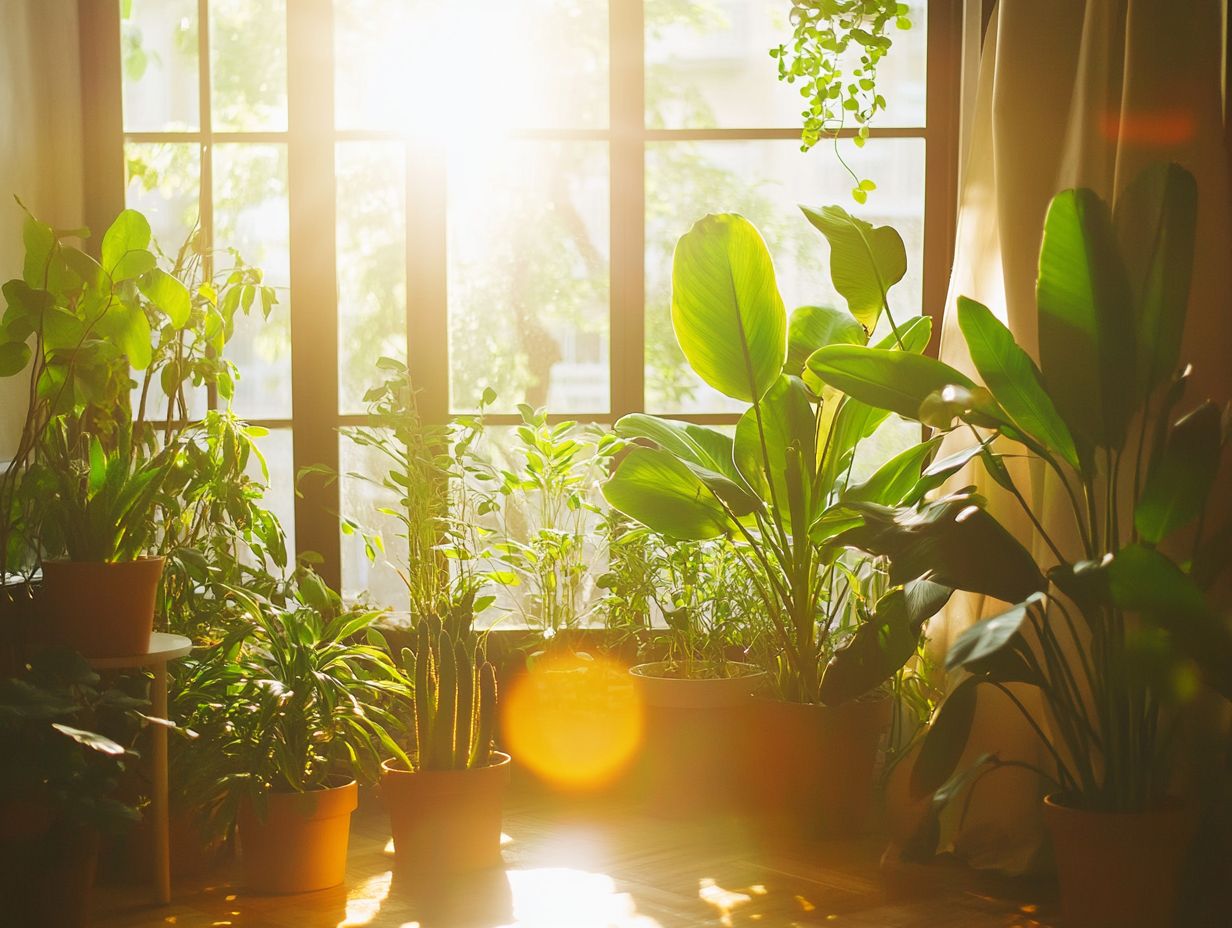
- Sunlight is essential for indoor plants to thrive as it provides necessary energy for photosynthesis and promotes healthy growth.
- The amount and quality of sunlight should be considered when choosing and caring for indoor plants.
- Maximize sunlight by strategically placing plants near windows and using artificial lighting as a supplement when needed.
The Importance of Sunlight for Indoor Plants
Sunlight is essential for your indoor plants, serving a vital role in photosynthesis, which is key to their growth and overall health. Without sufficient sunlight, your beloved houseplants, such as the African violet and Pothos, may find it challenging to thrive, resulting in stunted development and diminished vitality.
For those passionate about indoor gardening, ensuring your plants receive the right amount of light is crucial for cultivating a lush and vibrant atmosphere. The advantages of proper light exposure go beyond just looking good; they also enhance energy efficiency in your home environment.
Why Sunlight is Essential for Plant Growth
Sunlight is vital for your plants’ growth, serving as the catalyst for photosynthesis the remarkable process through which plants transform light energy into the chemical energy that fuels their development.
This intricate mechanism thrives under various conditions, particularly light intensity and specific wavelengths, which are key to optimizing its efficiency. For example, your houseplants, like Pothos and Spider Plant, flourish best in bright, indirect sunlight, while more delicate varieties, such as the African Violet, prefer filtered light to avoid the dreaded leaf burn.
Regarding wavelengths, red light is essential for supporting flowering and fruiting stages, while blue light is crucial for that lush vegetative growth. Understanding these light requirements allows you to create ideal environments that significantly boost your plants’ growth and vitality.
Factors to Consider for Indoor Plant Sunlight
When you care for indoor plants, it’s essential to consider several factors to ensure they receive the optimal light exposure. This includes evaluating light intensity, duration, and the specific requirements of each plant type.
By paying attention to these elements, you can create a thriving indoor garden that meets the unique needs of your greenery.
Amount and Quality of Light
The amount and quality of light are essential for your houseplants, as they directly impact their growth patterns, flowering, and overall health.
To effectively nurture these plants, it s important to grasp measurements like foot-candles (a unit that measures light intensity) and lumens, which quantify light intensity and exposure. Each type of plant has its own unique light requirements, and understanding how to fulfill those needs can make a notable difference in their vitality.
The spectrum of light also plays a crucial role; it influences processes like photosynthesis, greatly affecting plant vigor and bloom. By utilizing various light sources, such as energy-efficient LED lights that emit a full spectrum or fluorescent tubes that provide balanced illumination, you can create ideal indoor conditions.
This approach not only optimizes plant care but also brings you joy in your gardening endeavors.
Ready to transform your indoor garden? By applying these insights on sunlight, you ll soon see your indoor plants thrive!
Types of Plants that Thrive in Sunlight
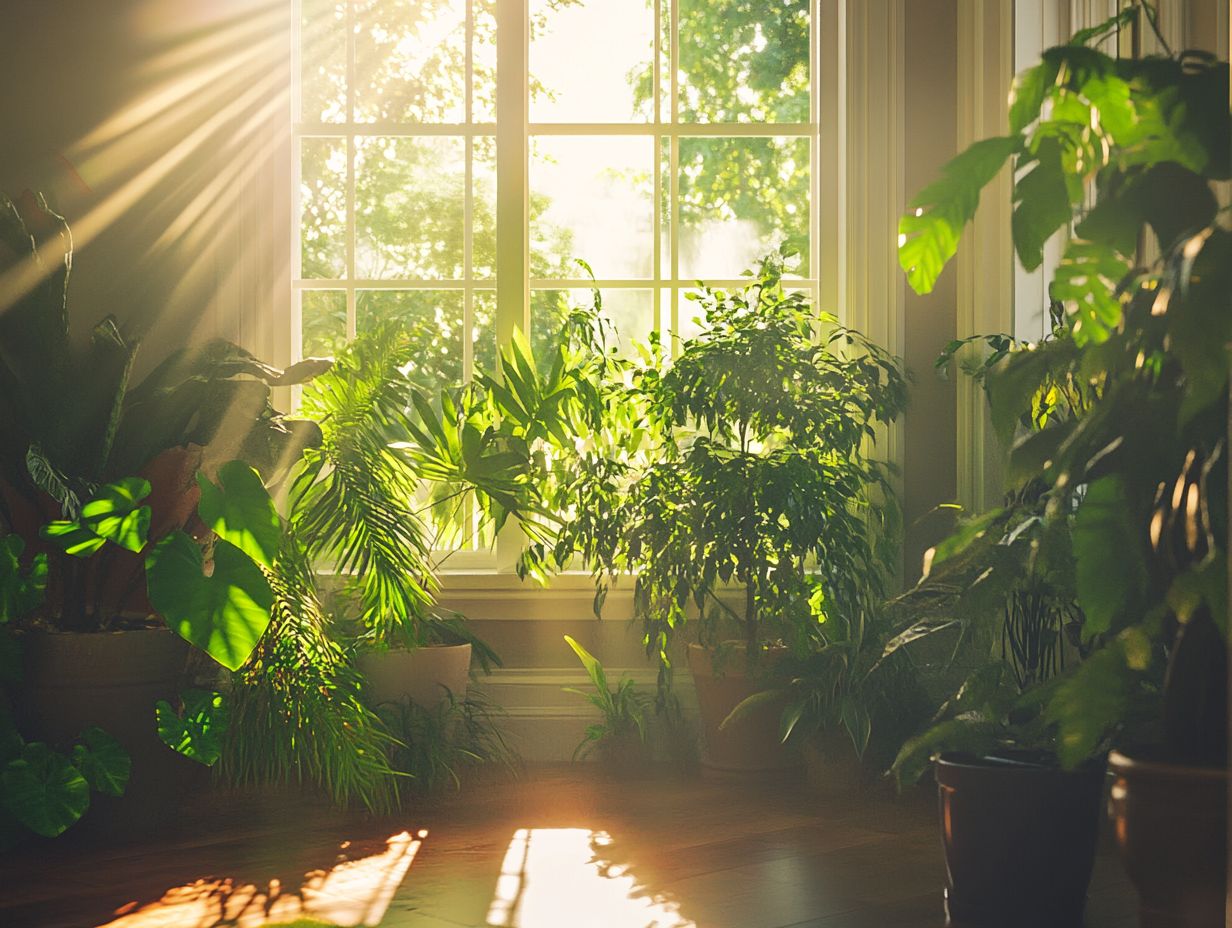
Certain plant types absolutely thrive in sunlight, showcasing bright foliage and vibrant blooms that make them perfect for an indoor gardening enthusiast like yourself.
These plants don t just add a splash of color to your space; they elevate the overall atmosphere with their refreshing aesthetics. If you’re looking to create a vibrant oasis in your home with stylish indoor decorations, consider succulents and cacti, which flourish in direct sunlight and require minimal watering perfect for your busy lifestyle.
On the other hand, tropical plants like pothos and snake plants adapt beautifully to indirect lighting, bringing lush greenery into your environment. For those sun-drenched spots in your home, don t overlook the stunning options of hibiscus or geraniums.
With these choices, you can suit different light conditions while cultivating a spectacular indoor garden that truly reflects your style.
How to Maximize Sunlight for Indoor Plants
Maximizing sunlight for your indoor plants requires thoughtful placement and positioning. By carefully considering each plant’s needs, you can ensure that they receive the ideal light exposure essential for their best growth.
Placement and Positioning of Plants
The proper placement and positioning of your indoor plants is crucial for ensuring they receive the sunlight they need to flourish.
Understanding the light conditions in various rooms can significantly impact how well your houseplants thrive. For example, spots near south-facing windows generally offer abundant direct sunlight, making them perfect for sun-seeking varieties like succulents and cacti.
On the other hand, north-facing areas provide lower light, ideal for shade-loving plants such as snake plants and pothos.
To enhance light exposure, think about incorporating reflective surfaces like mirrors or light-colored walls, which can beautifully bounce natural sunlight throughout the room. By positioning your plants near these surfaces, you ll amplify their illumination, creating a vibrant indoor garden even in spaces that aren t drenched in natural light.
Using Artificial Lighting as Supplement
You ll love the benefits of these lighting options! Artificial lighting, like LED lights and fluorescent tubes, is an excellent choice for supplementing light for your indoor plants, especially in those low-light corners of your home.
These lighting options provide significant advantages, including energy efficiency and the ability to closely mimic the spectrum of natural sunlight an essential ingredient for photosynthesis. LEDs, in particular, are a game-changer; they consume less power and outlast traditional bulbs, making them a smart and sustainable choice for any home gardener.
To elevate your plant care routine, consider mixing different lighting setups to tailor the environment to your plants’ needs. For example, using full-spectrum LED lights, which provide a range of colors to support plant growth, during the day alongside softer fluorescent lights in the evening can foster robust growth.
You can adjust the distance and duration of light exposure to further enhance growth by mimicking the seasonal changes in daylight that your indoor plants crave.
Common Mistakes to Avoid
Avoiding common mistakes in plant care is essential for ensuring your indoor plants thrive, especially when it comes to achieving the right balance of sunlight exposure and understanding their light categories.
By paying attention to their needs, you can cultivate a flourishing indoor garden that brings life and vitality to your space.
Don’t miss out on creating your dream indoor garden!
Overexposure to Sunlight

Overexposing your indoor plants to harsh sunlight can spell disaster, resulting in unsightly leaf burn and stunted growth, particularly in sensitive plants like the maidenhair fern or phalaenopsis orchid. It’s essential to recognize the signs of overexposure to maintain your plants health.
Keep an eye out for crispy edges, faded or yellowing leaves, and even premature leaf drop these symptoms indicate that your plants might be soaking up too much light. For those nurturing sensitive plants, monitoring light conditions becomes even more crucial.
To adjust light exposure, consider these strategies:
- Move your plants further away from direct sunlight.
- Use sheer curtains to soften those intense rays.
- Rotate your pots regularly to ensure even light distribution.
By making these adjustments, you ll protect delicate foliage and foster vibrant growth.
Not Providing Enough Sunlight
Not providing sufficient sunlight is a common pitfall that can significantly impede the growth and health of your houseplants, ultimately leading to their decline. This lack of adequate light can cause stunted growth, weak stems, and faded leaves, all of which can place considerable stress on your plants.
Many indoor gardeners often overlook the sunlight needs of various species, mistakenly believing that even the hardiest plants can thrive in low light conditions. To encourage robust growth, it’s crucial to grasp the unique light needs of each type of plant.
A practical solution for enhancing light exposure is to position your plants strategically near windows or utilize reflective surfaces to maximize sunlight. Incorporating artificial lighting, like LED grow lights lights specifically designed to help plants grow by providing the right type of light they need can provide essential wavelengths that many plants need, ensuring they flourish even in less-than-ideal conditions.
Troubleshooting Sunlight Issues
Troubleshooting sunlight issues is crucial for the well-being of your indoor plants. When light exposure is inadequate or excessive, it can lead to a range of growth challenges that are easily avoidable. By paying attention to your plants’ lighting needs, you can ensure they thrive and flourish in your space.
Signs of Insufficient Sunlight
Identifying the signs of insufficient sunlight is essential for your plant’s well-being, as many houseplants clearly show symptoms when they aren t getting enough light. Keep an eye out for leggy growth, where the stems stretch eagerly toward the nearest light source, along with yellowing leaves that signal distress.
A plant that s not thriving may lose its vibrant color and struggle to produce new growth, all clear indicators that something isn t quite right in its environment. To properly assess your plant’s light requirements, start by examining its position relative to windows or light fixtures.
You might need to adjust your care routine perhaps moving the plant closer to a light source or adding some artificial lighting to the mix. Regular observation will help you ensure that your plant gets just the right amount of light for optimal health.
Correcting light-related issues requires you to adjust your plants’ environment and care routine, ensuring they bask in optimal light conditions. Start by assessing where your plants currently reside. Are they soaking up enough sunlight?
If they seem a bit sluggish, it might be time to move them closer to a window or into a brighter part of the room. You can also elevate the brightness in those shadowy corners by adjusting light fixtures think repositioning overhead lights or incorporating reflective surfaces. When natural light falls short, adding supplemental sources like grow lights can work wonders for their growth.
Regularly monitoring light conditions is essential, especially as seasons shift or new furniture makes its debut. This proactive strategy nurtures your plants and transforms your space into a vibrant indoor oasis. Act now to ensure your plants thrive!
Taking these simple steps will help your indoor plants flourish and bring joy to your home. Share your plant care experiences or ask questions below!
Frequently Asked Questions
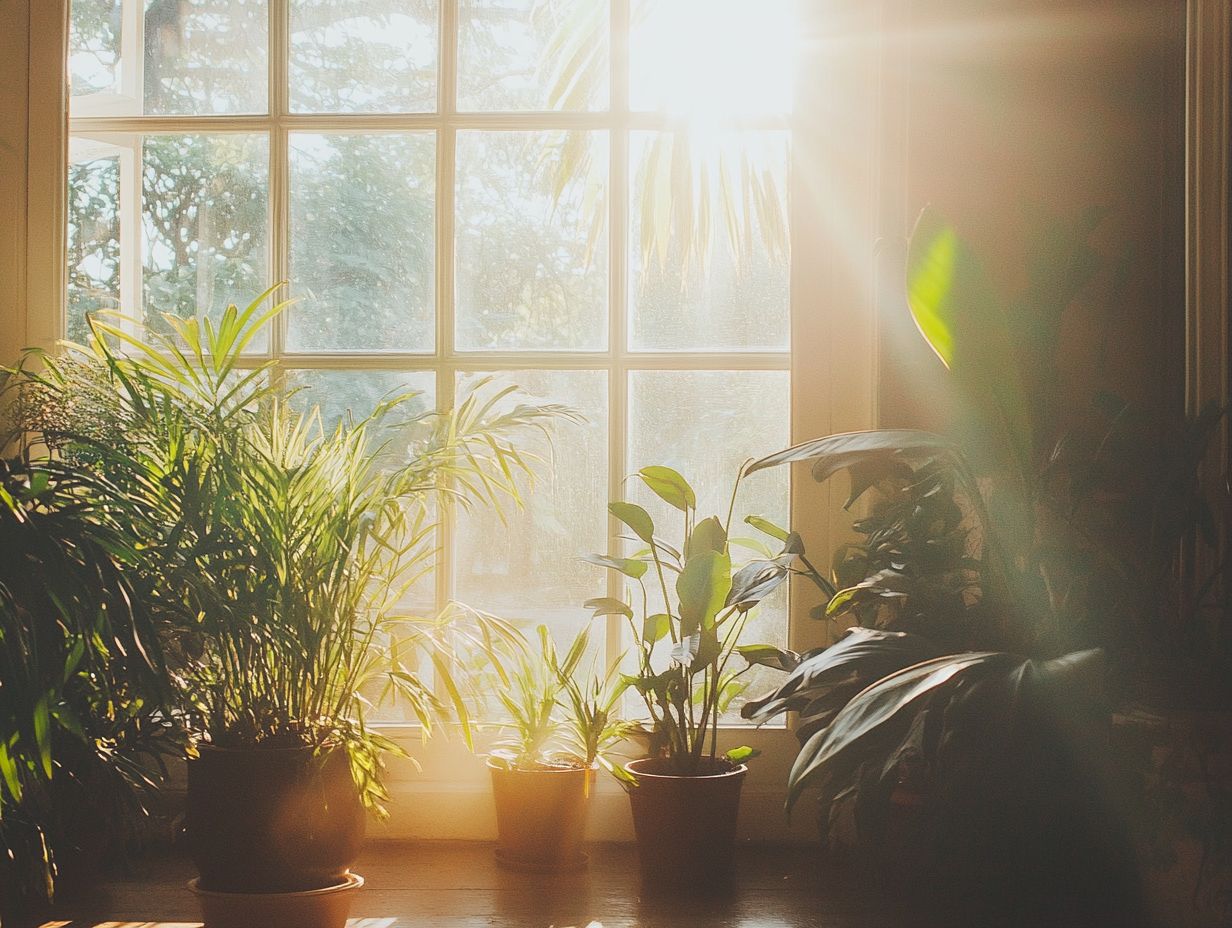
Can I use sunlight for all types of indoor plants?
Most indoor plants love natural sunlight! It helps them grow strong and healthy. However, some plants prefer indirect sunlight, so it’s important to know what your specific plants need.
How much sunlight do indoor plants need?
Plants have different sunlight needs. Some love direct sun, while others prefer shade. Research your plants to find out their specific requirements!
What are the best ways to use sunlight for indoor plants?
Place your plants by a sunlit window for a few hours daily. Rotate them regularly to ensure even sunlight exposure.
Can I use artificial light for indoor plants instead of sunlight?
You can use artificial light instead of sunlight! LED grow lights are a great option for plant growth.
What are the signs that my plants are not getting enough sunlight?
Look out for wilting leaves and leggy stems these are signs your plants are craving more sunlight!
How can I optimize the use of sunlight for my indoor plants?
Keep your windows clean to let in as much light as possible. Reflective surfaces can help spread light to darker spots. If needed, add some artificial light!

